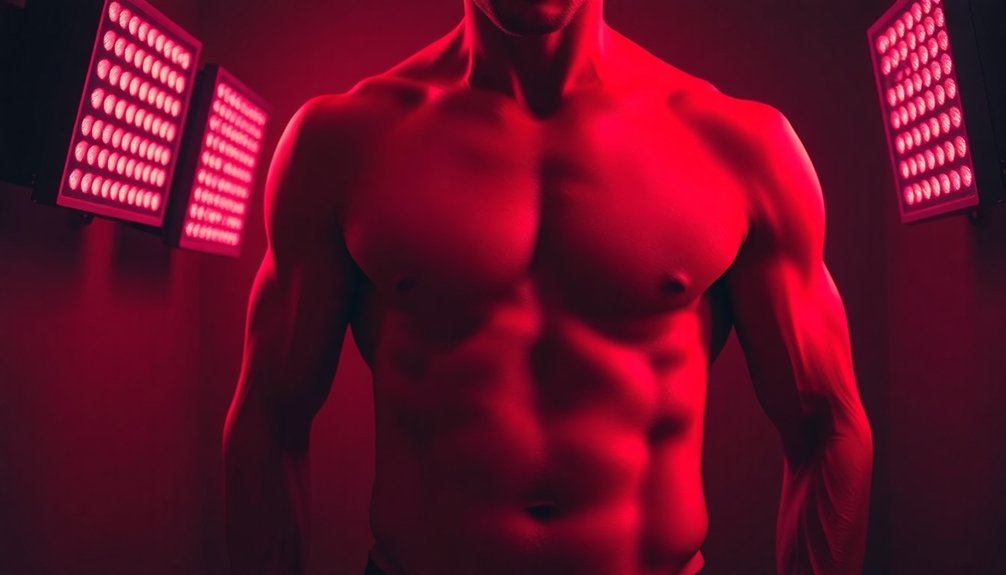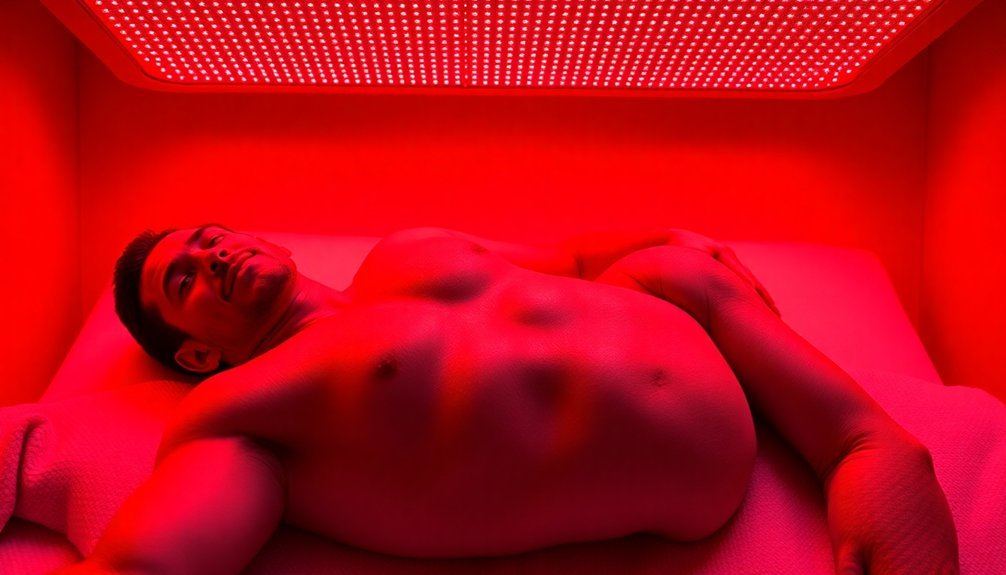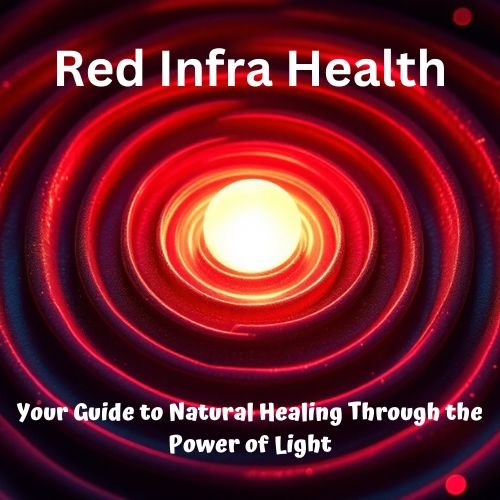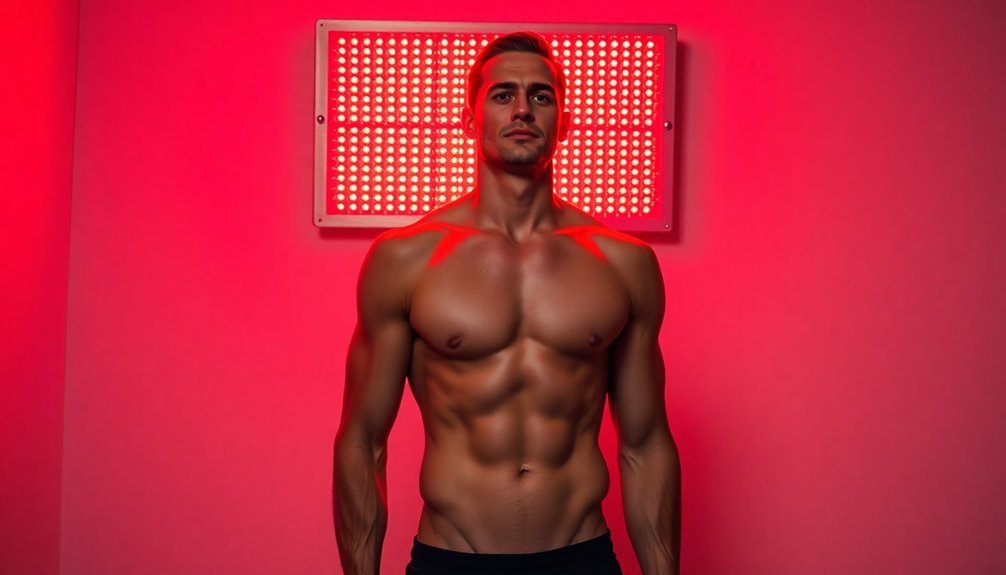Red light therapy can supercharge your male hormones in three key ways. First, it stimulates your Leydig cells – the testosterone-producing powerhouses in your testicles – helping them function more efficiently. Second, it activates your mitochondria, boosting cellular energy production that's essential for hormone synthesis. Third, it triggers the release of nitric oxide, improving blood flow and delivering crucial nutrients to hormone-producing tissues while reducing inflammation and oxidative stress. When combined with exercise, these effects create a powerful synergy that optimizes your body's natural testosterone production. Discover how this groundbreaking therapy can transform your hormone health.
Stimulating Testosterone-Producing Leydig Cells

Three key players work together to stimulate testosterone production in Leydig cells: Luteinizing Hormone (LH), cyclic AMP (cAMP), and protein kinase A (PKA). When LH binds to receptors on your Leydig cells, it triggers a cascade of events that boost testosterone production. This binding activates adenylyl cyclase, which increases cAMP levels inside your cells.
The increased cAMP then activates PKA, which phosphorylates specific proteins vital for testosterone synthesis. This process enables cholesterol – the building block of testosterone – to move into the mitochondria through specialized proteins like STAR (steroidogenic acute regulatory protein). The steroidogenic enzyme activities gradually decrease as Leydig cells age, further compromising testosterone production.
As you age, this intricate system becomes less efficient. Your Leydig cells face increased oxidative stress and elevated COX-2 levels, which impair their ability to produce testosterone.
You'll also experience a decline in both Leydig cell numbers and their responsiveness to LH stimulation. This combination of factors leads to decreased testosterone production, potentially resulting in hypogonadism.
Understanding this mechanism is vital because it helps explain why maintaining healthy Leydig cell function is essential for ideal testosterone levels throughout your life.
Boosting Mitochondrial Energy Production
Your mitochondria's energy production capabilities directly influence testosterone levels through a sophisticated interplay between cellular energy and hormone synthesis. When you expose your cells to red and near-infrared light, you're activating these cellular powerhouses to produce more ATP, which is essential for hormone production and regulation.
Red light therapy enhances this process by dislodging nitric oxide from the energy production chain, making your mitochondria more efficient. This increased efficiency doesn't just boost energy – it creates a cascade effect that optimizes hormone production, including testosterone. Similar to how sex steroids enhance efficiency in brain mitochondria, red light therapy optimizes cellular energy production throughout the body.
The therapy also triggers mitochondrial biogenesis, meaning you'll create new mitochondria, further amplifying your cellular energy capacity.
You'll experience enhanced blood flow as the released nitric oxide acts as a vasodilator, delivering more nutrients and oxygen to hormone-producing cells. This improved circulation helps reduce oxidative stress and inflammation, which can otherwise impair testosterone production.
When you combine red light therapy with exercise, you're creating a powerful synergy – exercise naturally stimulates mitochondrial function, while red light therapy optimizes this process, potentially leading to better hormone regulation and testosterone production.
Enhancing Blood Flow

Blood flow enhancement through red light therapy delivers a powerful boost to hormone production and regulation. When you expose your body to red and near-infrared light, it triggers the release of nitric oxide, a natural vasodilator that widens your blood vessels and improves circulation throughout your system.
This enhanced blood flow creates a cascade of beneficial effects. Your tissues receive more oxygen and nutrients, while toxic byproducts are efficiently removed from your circulatory system. For male hormone production specifically, improved blood flow to the testicles supports ideal function and hormone synthesis. The stabilization of pH levels throughout the body helps maintain optimal hormone balance.
You'll experience both immediate and long-term benefits from this increased circulation. The light therapy stimulates beneficial physiological responses in your cells and tissues, supporting proper nerve sensitivity and reducing inflammation.
This improved blood flow doesn't just help with hormone production – it also aids in post-workout recovery, pain management, and overall tissue health.
Your body's natural healing processes are enhanced through this improved circulation, creating an ideal environment for hormone balance. The combination of vasodilation and enhanced microcirculation helps maintain healthy tissue function while supporting your endocrine system's ability to produce and regulate hormones effectively.
Frequently Asked Questions
Can Red Light Therapy Affect Fertility if Used Too Frequently?
While there's no clear evidence that frequent red light therapy harms fertility, you shouldn't overuse it. Stick to recommended 20-30 minute sessions and consult a healthcare provider for personalized treatment guidelines.
Does Wearing Clothes During Treatment Reduce the Effectiveness for Testosterone Production?
Yes, wearing clothes, especially synthetic fabrics, will reduce red light therapy's effectiveness for testosterone production. You'll get the best results with direct skin exposure, as clothing can block or interfere with the light's benefits.
How Long Does It Take to Notice Increased Testosterone Levels?
You'll typically notice increased testosterone levels after several weeks of consistent red light therapy sessions. Most people see significant changes when following the recommended 10-20 minute treatments 3-4 times per week.
Should Red Light Therapy Be Avoided During Certain Medical Treatments?
Yes, you'll need to avoid red light therapy during cancer treatments, especially radiation or chemotherapy. You should also be cautious if you're taking photosensitive medications or have certain skin conditions. Always consult your doctor first.
Can Red Light Therapy Cause Hormone Imbalances in Younger Men?
While red light therapy is generally safe for younger men, you should consult your doctor first. Studies haven't shown hormone imbalances, but individual responses can vary based on your specific health conditions.
In Summary
You've discovered how red light therapy can naturally optimize your testosterone levels through three key mechanisms: stimulating Leydig cell function, powering up your mitochondria, and improving blood circulation. By incorporating regular red light sessions into your routine, you'll support your body's hormone production while enjoying better energy and essentialness. Start with just 10-15 minutes daily to experience these hormone-boosting benefits for yourself.





Leave a Reply